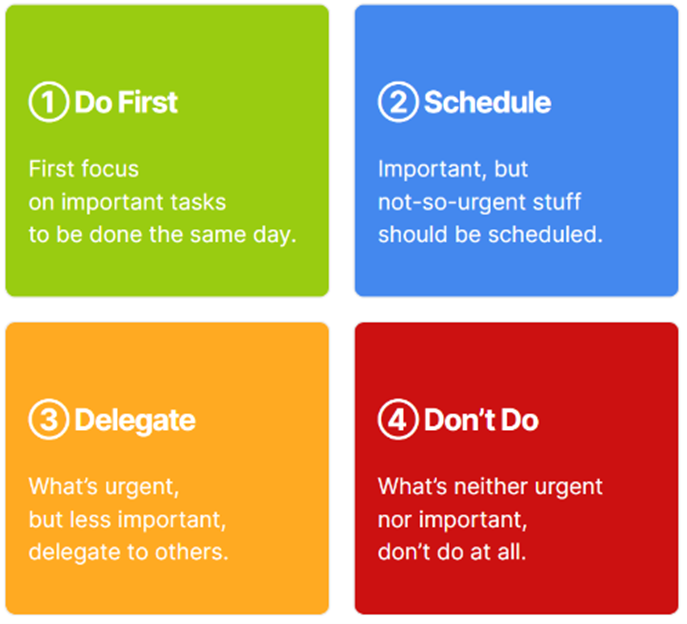Pro Tips: Mindful Prioritisation
ETHOS Digital Issue 11, Oct 2023

- Read more
- Eat healthy
- Drink more water
- Run every day
- Join a gym
- Spend more time with family
- Spend more time with friends
- Meditate every morning
- Save money
- Focus on professional growth
- Sleep early
Do you start the year with a long list of resolutions, only to find yourself sticking to none of them as the weeks go by?
Many of us start our year listing all the things we want to change or start doing. But often, this just leads to a greater chance that we will not accomplish anything on the list.
Trying to make too many big changes at once or in too many areas of our lives (e.g., work, relationships, health, etc.) is usually a recipe for failure.
Instead, you may find it better to aim for one small concrete change and sticking to it. What is most important is to choose and commit to a change that is most aligned to your values and aspirations.
When many things are given priority, in fact nothing is.
What Prioritising Really Means
The word priority is derived from the Old French priorite, meaning "state of being earlier (than something else), prior occurrence or existence", and the Latin prioritas, meaning “first in rank, order, or dignity”. There can only be one first thing—one priority. As Greg McKeown explains in his book Essentialism, the illogical notion that we can have multiple priorities, or more than one ‘first thing’, came about only relatively recently. When many things are given priority, in fact nothing is.1
It would be like highlighting all the text in a textbook: which would defeat the purpose of highlighting anything at all.
When making resolutions, what’s needed is an actual priority: one item considered more important than the others on the list. This also applies to work: what is really the most important thing? We need to be especially mindful of this when workloads increase and we find our to-do lists getting longer and longer.
How to prioritise
One tool to help prioritise tasks is the Eisenhower Box, which is featured in Stephen Covey's widely read 7 Habits of Highly Effective People. You might also know it as The Time Management Matrix, The Eisenhower Method, or The Urgent-Important Matrix.
The idea is to focus on what will make you most effective, not just most productive.
According to the framework, all day-to-day tasks and bigger projects fall into one of four quadrants, depending on how urgent and important they are.
Urgent tasks are those which are externally driven, usually by deadlines. They require immediate attention but spending too much time on them (also known as ‘firefighting’) can lead to stress and anxiety, causing you to lose sight of the bigger picture.
Tasks are considered important based on what matters to you personally. Such tasks contribute to your long-term goals and call for more thoughtful planning and action. As these tasks may not produce immediate results, they often tend to get neglected when your time is consumed by urgent demands.

Source: Eisenhower
- Quadrant 1: Urgent & Important Tasks/Projects—Complete Immediately
- Quadrant 2: Not Urgent & Important Tasks/Projects—Schedule on Your Calendar
- Quadrant 3: Urgent & Unimportant Tasks/Projects—Delegate to Someone Else
- Not Urgent & Unimportant Tasks/Projects—Delete
- These tasks are time-sensitive and need to be done as soon as possible: they should be tackled first. They are likely to have a palpable deadline, but may also be time-sensitive tasks like preparing to conduct a survey after a specific event.
- As you plan your workday or week, make sure you have assigned time to complete these tasks.
- These tasks don’t demand immediate action but they do contribute to long-term goals. So it is important to include these tasks in longer-term schedules or they may end up becoming urgent and moved into the first quadrant. Tasks related to professional development and upskilling would fall into this quadrant. They are not usually immediate concerns but they do improve effectiveness and efficiency at work in the long run.
- Tasks in this quadrant are time-sensitive but not super important. Such tasks often prevent those in quadrant 1 or 2 from being completed. They could be essential but routine administrative tasks that do not require our specific skillsets. In research work, these could include tasks like transcribing interviews, sending email invites to event participants, or data cleaning. Such tasks are best delegated, although being in a small work team can make this challenging, especially if everyone has their share of such tasks to complete.
- Another way to manage these tasks is to outsource or automate them (i.e., delegate them to external vendors, or to machines). For instance, AI-driven software such as Otter.Ai or GovTech’s Transcribe has become an attractive option for transcription. We can spend some of our Quadrant 2 time to think about how to use technology to ease such routine processes, saving us time and energy in the longer run.
- Tasks in this quadrant are not absolutely necessary and can usually be dropped.
- As researchers, we may come across a side topic in our field that piques our interest and tempts us to explore in a different direction from our original aims. We have to be mindful of how important these topics are in the larger context of our work, and whether they have a meaningful impact on our stakeholders and customers. At times, it could be beneficial to document these ideas for future reference instead of outright deleting them. This allows us to shift them to other quadrants to be scheduled again, should they become important in future.
We can spend some of our time to think about how to use technology to ease routine processes, saving time and energy in the longer run.
Tools such as the Eisenhower Box can help us move past the dilemma of what to do or not do, while keeping in mind our longer-term goals. Give it a try before the next time things get crazy!
NOTES
- Greg McKeown, Essentialism: The Disciplined Pursuit of Less (Currency, 2014).
- Eisenhower, “Introducing the Eisenhower Matrix”, https://www.eisenhower.me/eisenhower-matrix/.

